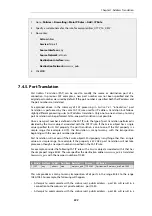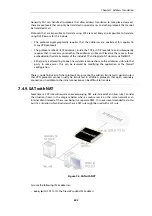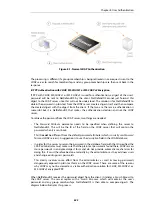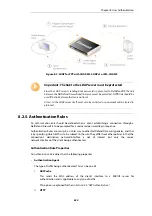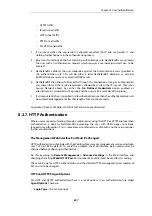
available to clients. Authentication of a server is achieved by opening a single connection once
to NetDefendOS as though the server were a client.
The purpose of this is to restrict access to certain networks to a particular group by having IP
rules or policies which will only apply to members of that group. To gain access to a resource
there must be an IP rule or policy that allows it and the client must belong to the same group as
that specified for the
Source Network
or
Destination Network
address object.
For an example of setting up user authentication using group membership, see
“User Authentication Setup for Web Access”
which is found later in this section.
PPTP/L2TP Configuration
If a client is connecting to the NetDefend Firewall using PPTP/L2TP then the following three
options called also be specified for the local NetDefendOS user database:
•
Static Client IP Address
This is the IP address which the client must have if it is to be authenticated. If it is not
specified then the user can have any IP. This option offers extra security for users with fixed IP
addresses.
•
Network behind user
If a network is specified for this user then when the user connects, a route is automatically
added to the NetDefendOS
main
routing table. This existence of this added route means that
any traffic destined for the specified network will be correctly routed through the user's
PPTP/L2TP tunnel.
When the connection to the user ends, the route is automatically removed by NetDefendOS.
Caution: Use the network option with care
The administrator should think carefully what the consequences of using this option
will be. For example, setting this option to
all-nets
will possibly direct all Internet
traffic through the tunnel to this user.
•
Metric for Networks
If the Network behind user option is specified then this is the metric that will be used with
the route that is automatically added by NetDefendOS. If there are two routes which give a
match for the same network then this metric decides which should be used.
Note: Other authentication sources do not have the PPTP/L2TP
option
Specifying an SSH Public Key
With PPTP/L2TP clients, using a key is often an alternative to specifying a username and
password. A private key can be specified for a local database user by selecting a previously
uploaded NetDefendOS
SSH Client Key
object.
When the user connects, there is an automatic checking of the keys used by the client to verify
their identity. Once verified, there is no need for the user to input their username and password.
Chapter 8: User Authentication
613
Summary of Contents for NetDefendOS
Page 30: ...Figure 1 3 Packet Flow Schematic Part III Chapter 1 NetDefendOS Overview 30 ...
Page 32: ...Chapter 1 NetDefendOS Overview 32 ...
Page 144: ...Chapter 2 Management and Maintenance 144 ...
Page 284: ...Chapter 3 Fundamentals 284 ...
Page 392: ...Chapter 4 Routing 392 ...
Page 419: ... Host 2001 DB8 1 MAC 00 90 12 13 14 15 5 Click OK Chapter 5 DHCP Services 419 ...
Page 420: ...Chapter 5 DHCP Services 420 ...
Page 573: ...Chapter 6 Security Mechanisms 573 ...
Page 607: ...Chapter 7 Address Translation 607 ...
Page 666: ...Chapter 8 User Authentication 666 ...
Page 775: ...Chapter 9 VPN 775 ...
Page 819: ...Chapter 10 Traffic Management 819 ...
Page 842: ...Chapter 11 High Availability 842 ...
Page 866: ...Default Enabled Chapter 13 Advanced Settings 866 ...
Page 879: ...Chapter 13 Advanced Settings 879 ...

